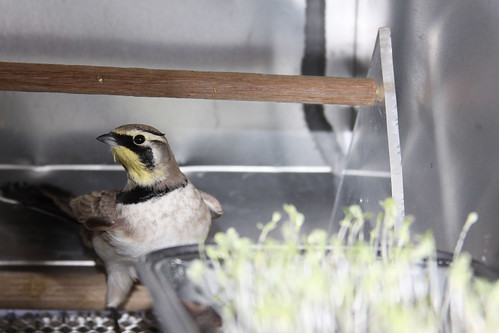
A captive horned lark is offered lettuce seedlings treated with a bird repellent. Photo by USDA Wildlife Services
California is the “bread basket” of American agriculture. In 2012, California’s 80,500 farms and ranches produced a record $44.7 billion in produce, dairy, and meats. With more than 400 crop varieties grown in the State, California produces nearly half of all U.S. grown fruits, nuts and vegetables.
To help ensure this basket stays full, the California Department of Food and Agriculture (CDFA) partners with APHIS Wildlife Services (WS) to address wildlife damage issues to agriculture. Some of the more recent work involves the development of repellents to protect crops from birds.
Birds can cause substantial damage by feeding on newly planted or ripening crops. For example, horned larks damage lettuce, spinach, carrots, beets, turnips, and peas; American crows damage almonds; great-tailed grackles eat a variety of citrus crops; and wild turkeys consume an assortment of crops from corn and wheat to strawberries, peanuts, and ginseng. In a recent study, WS economists estimated bird damage to California’s wine grape, blueberry, and cherry crops alone accounted for $64 million in losses each year.
From 2010-2013, WS experts at the National Wildlife Research Center and colleagues at the University of Mississippi and Arkion Life Sciences LLC conducted a series of CDFA-funded studies to test the effectiveness of an anthraquinone-based bird repellent to protect almonds, lettuce, melons, and ginseng from bird damage. Some anthraquinones, which occur naturally in plants, have been reported to cause repellency in some animals. In addition, anthraquinone absorbs near-ultraviolet (UV) light (a portion of the light spectrum not visible to humans) that is visible to birds. This visual cue may facilitate its repellency effect in birds.
In studies with captive horned larks, American crows, great-tailed grackles, and wild turkeys, scientists identified the minimum amount of an anthraquinone-based repellent needed to reduce bird consumption of repellent-treated crops by at least 75 percent. One study also discovered that wild turkeys that ate 100 milligrams of anthraquinone subsequently avoided food treated only with an UV-absorbent cue. Researchers conclude that UV cues could be used to enhance the effectiveness of repellents and, once birds gain experience, could be used to fool them into avoiding UV-treated crops that do not include repellent applications. These studies aid in the development and registration of economically-feasible, safe, and effective bird repellents for use on food crops.
To learn more about WS research related to bird damage to agriculture, please visit our Web site.
No comments:
Post a Comment